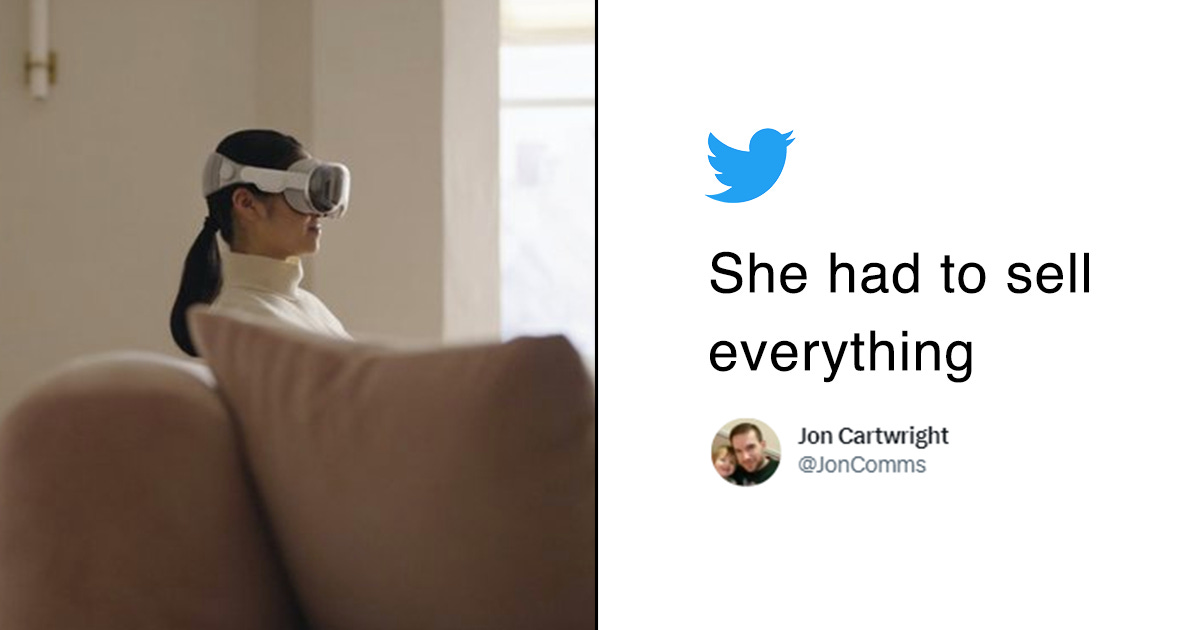Is the Apple Vision Pro the computer's successor? 🥽
A new ideal for knowledge workers, competition with Meta & similarities with the first iPhone
Hey there,
Is the Apple Vision Pro the computer's successor?
The hardware (sensors and chips) is impressive. But what are the best user cases for such glasses? And why did Apple choose a different strategy than Meta with the Oculus Rift?
Happy reading!
–Peter Joosten
PS. If you can understand Dutch, this is my podcast about this topic.
Vision Pro as successor to the computer?
In June 2023, Apple CEO Tim Cook presented the Vision Pro. Glasses for augmented and virtual reality. Or in the words of Apple itself: spatial computing.
The device has no less than 12 cameras, 6 microphones, 5 sensors (for hand movements and to map the environment), Lidar sensors, 4 infrared cameras and two specialized processors.
But what can you do with these impressive specs? In the announcement, Apple showed examples such as watching sports games, viewing movies and FaceTime with family members.
Ideal for knowledge workers
After the first messages I was still a bit skeptical. How is this device different from competitor predecessors like the Google Glass or Meta's Oculus?
Martijn Aslander is a good friend of mine. A few years ago, he was an important driver of my career as a speaker. A few days after the presentation of the Vision Pro, he called me enthusiastically.
His argument is that the Vision Pro fits perfectly with the modern knowledge worker. We currently mainly work with flat screens and A4-sized documents. But from an evolutionary point of view, spatial thinking in our brains is the most developed. We can use it for working creatively and efficiently.
Example: memory athletes
Think of memory athletes, as described in the book Moonwalking with Einstein. They remember the order of an entire deck of cards as follows:
each card has a talking association (think of Donald Trump as the king of spades);
you place the associations in places in a house that you imagine. For example: immediately after the front door, Donald Trump is standing in front of you. This reminds you that the king of spades was the first card.
This is just a simple example of spatial thinking. Some other ideas that we might use Apple's glasses for later:
As an architect you can easily construct a number of variants of a building;
As a CAD draftsman you can make simulations of your technical sketches;
Brainstorm as a team in stimulating places, such as the Hogwarts dining hall (from the Harry Potter stories)
World leaders negotiating peace in places that give perspective, such as on the Moon with the Earth in the distance.
Illustrious predecessors
With all its technical ingenuity, Apple is able to make these glasses a success. Think of her predecessors:
The first iPhone didn't have an App Store or even a GPS.
The first Apple Watch was received lukewarm, but the company was already focusing on healthcare with all kinds of sensors.
The same caveats apply to the Vision Pro as to the iPhone and the Apple Watch. And think also of the privacy of the user, the ownership of the data and the high cost of the device.
Whether the Vision Pro will soon be in the same list as the iPhone remains to be seen. But still, I think the glasses are an important contender to eventually replace the computer.
My keynote as a hologram
The Vision Pro is a form of augmented reality. That reminded me of my performance as a hologram at the Inspiration Festival of Hogeschool Windesheim.
Watch the video below (12 minutes) about what that was like, how it works and what tips I have (in Dutch):
📺 Media & Tech tips
Interesting articles, books, podcasts, videos, documentaries I recommend to check out!
1. READ / Ben Thompson is often spot on in his analyzes of technology company strategy. He is even more enthusiastic about the Vision Pro than he expected.
2. READ / Interesting analysis from The Economist that focuses more on the business side of the Vision Pro.
3. WATCH / Marques Brownlee tested the Vision Pro himself.
🙏 Thank you for reading
This newsletter is free, but not cheap to make.
You can help me in a number of ways: forward it to someone who likes it, subscribe to my YouTube-channel, hire me to speak, for a workshop, or for a webinar.


